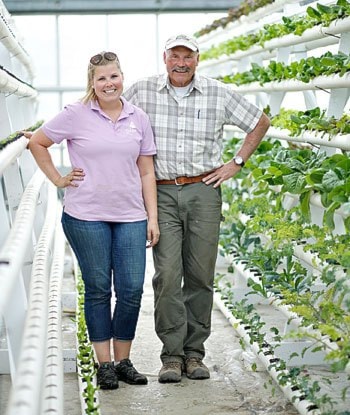Lorne Metropolit wants to go a step beyond selling locally grown vegetables: he wants to sell living vegetables.
To do that, the owner of Yukon Gardens will sell lettuce heads with the roots still attached.
And that’s easy for him to do because the lettuce will be grown hydroponically - meaning in water.
“We’re hoping the plant will keep growing,” Metropolit said.
“You’re getting a living plant - we’re hoping it will give you another day or two.”
Hydroponics uses water mixed with nutrients to grow plants and vegetables instead of using soil.
“It’s more plants in less expensive real estate property,” said Metropolit.
Compared to the size of its current hydroponics installation for lettuce - which occupies the same space two vans would - Metropolit said it would require him to use half of his greenhouse - many, many vans - to grow the same amount of lettuce in soil.
As well, “It will also remove the need to remove dirt,” he said.
The company is using a homemade hydroponics system.
Fifteen rods rest on an A-frame roughly the height of the greenhouse - about 2.5 metres.
Holes are drilled in each rod to host the plants. An irrigation system is attached to each of the rods, sending the water-nutrient mix five times a day to the plants.
The water is then drained and used for other growing installations.
The structure can grow up to 2,000 lettuce heads in one go, but Metropolit says they’re not growing them all at once.
“We don’t want to harvest the all 2,000 heads at once,” he said during a tour of his greenhouse on Wednesday.
“We’re just going to flood the market.”
Instead he hopes to be harvesting 400 heads every week until mid-October.
So far, the company has planted nine to 12 varieties of lettuce to look at which ones will do best.
One head of lettuce will take anywhere from 5.5 to 6.5 weeks to grow in the Yukon Gardens greenhouse.
“By the middle of the summer, we’ll be able to narrow it down to a handful of best growers and best sellers,” said Metropolit.
Three seeds are planted in a square of mineral wool used to anchor the plant, explained Metropolit’s daughter, Kelsey, the head grower at Yukon Gardens.
It’s not the first time they’ve been growing vegetables hydroponically, Metropolit notes: they’ve been growing tomatoes, cucumbers and zucchini using sawdust as an anchor for the past 27 years.
As for lettuce? Only for the past 27 hours, he jokes, as the company hasn’t harvested its first leafy green yet.
So far Metropolit has plans to sell the lettuce at Wykes’ Independent Grocer, the fruit stand on Black Street and Riverside Groceries.
The only thing Metropolit regrets is not having started sooner.
“We got an extremely early spring,” he said.
“For three weeks I’m an extremely popular guy!”
Metropolit said that hydroponics may have Yukon-wide applications, given how food security is a priority for many northern communities.
“We feel that if I can do this, other communities can do it too,” Metropolit said.
“It’s not that hard of a system once you get all the bumps out of the system.”
He said he is open to teaching other growers in the community.
At this year’s Yukon Innovation Prize, which focused on food security and agriculture, two projects involving hydroculture were among the four finalists.
The first aims to use duckweed growing on a hydroponic farm to feed ducks that would be sold for meat and eggs.
The second is an aquaponic system that would be able to grow plants and raise fish, each sustaining each other.
The winner of the Innovation Prize will be announced next June 15.
Contact Pierre Chauvin at
pierre.chauvin@yukon-news.com
